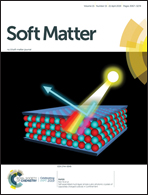Pillar[5]arene-based spongy supramolecular polymer gel and its properties in multi-responsiveness, dye sorption, ultrasensitive detection and separation of Fe3+†
Abstract
Herein, a novel way to design and construct multi-functional spongy supramolecular polymer gels through an easy to make tripodal guest (TA) and a naphthalimide functionalized-pillar[5]arene host (AP5) has been developed. According to this approach, a novel pillar[5]arene-based supramolecular polymer gel (SHG) was constructed via multi-non-covalent interactions such as host–guest inclusion, C–H⋯π, π⋯π and hydrogen bonds and so on. Interestingly, the SHG exhibits a spongy structure and strong aggregation induced emission (AIE). Furthermore, the SHG also exhibited multi-responsiveness toward outer stimuli such as heating–cooling, pH, competitive agents and mechanical. More importantly, the SHG xerogel shows separation properties for Fe3+, methyl orange, methylene blue and sudan I dyes. The separation rates of SHG xerogel for Fe3+ ions and organic dyes can reach up to 99.8%. Simultaneously, the SHG could ultrasensitively detect Fe3+ (LOD is 0.9 nM). In addition, a thin film based on SHG was also prepared, which was confirmed to be a convenient test kit for detecting Fe3+.
![Graphical abstract: Pillar[5]arene-based spongy supramolecular polymer gel and its properties in multi-responsiveness, dye sorption, ultrasensitive detection and separation of Fe3+](/en/Image/Get?imageInfo.ImageType=GA&imageInfo.ImageIdentifier.ManuscriptID=C8SM02482K&imageInfo.ImageIdentifier.Year=2019)


 Please wait while we load your content...
Please wait while we load your content...